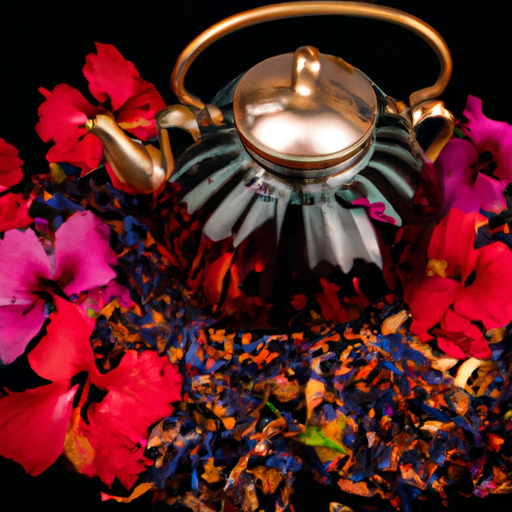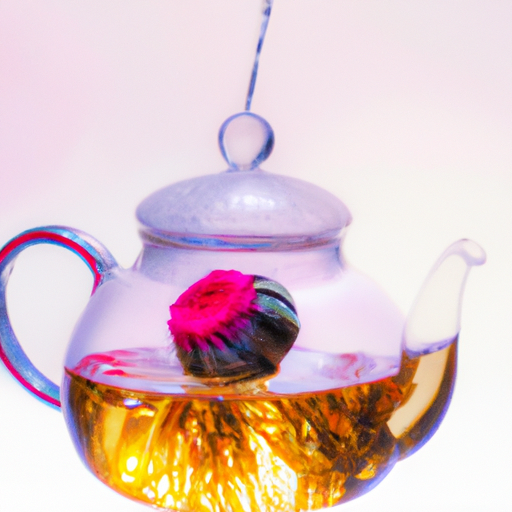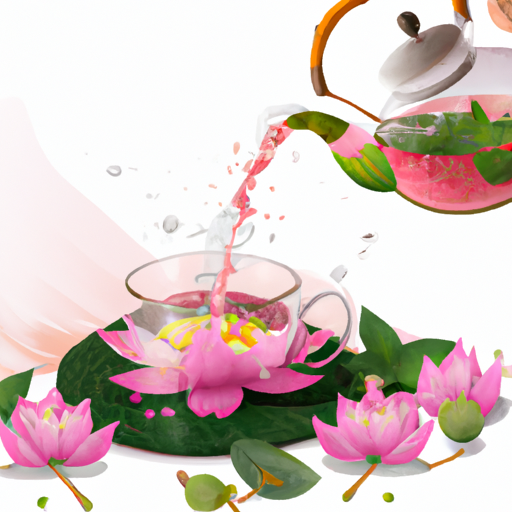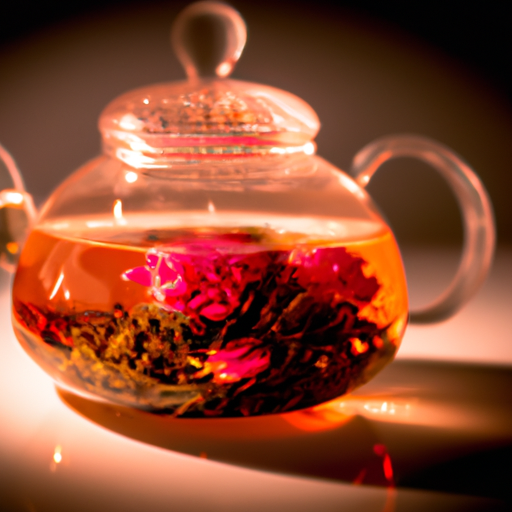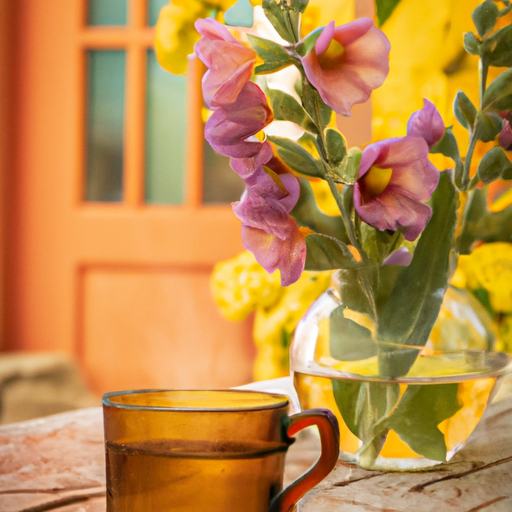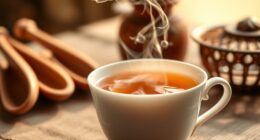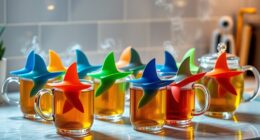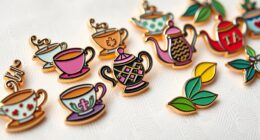Did you know that hibiscus tea is the second most popular herbal tea consumed worldwide?
With its vibrant color, refreshing taste, and numerous health benefits, it’s no wonder that hibiscus tea has gained such popularity.
But with so many different types of hibiscus flowers available, how do you know which one is the best for making tea?
In this article, I will guide you through the world of hibiscus flowers and help you choose the perfect one for your tea. We will explore the different flavor profiles, health benefits, and brewing methods of hibiscus flowers.
Additionally, I will provide tips on how to brew the perfect cup of hibiscus tea and discuss its culinary uses.
So, whether you’re a tea enthusiast or simply looking to incorporate more healthy beverages into your diet, read on to discover the wonders of hibiscus tea.
Key Takeaways
- The most common type of hibiscus flower used for tea is Hibiscus sabdariffa, also known as Roselle.
- Roselle hibiscus flowers have a tart and tangy flavor and are rich in antioxidants and vitamin C.
- Another type of hibiscus flower used for tea is Hibiscus rosa-sinensis, commonly known as Chinese hibiscus.
- Chinese hibiscus has a milder flavor with a hint of sweetness and is soothing for digestion.
Types of Hibiscus Flowers
When it comes to choosing the right hibiscus flower for tea, you’ll want to consider the various types available. Hibiscus flowers come in a wide range of flavor varieties and each type offers unique medicinal properties.
The most common type used for tea is Hibiscus sabdariffa, also known as Roselle. This variety has a tart and tangy flavor, making it perfect for brewing hot or iced tea. Additionally, Roselle hibiscus flowers are rich in antioxidants and vitamin C, which can boost the immune system and promote overall health.
Another type of hibiscus flower used for tea is Hibiscus rosa-sinensis, commonly known as Chinese hibiscus. This variety has a milder flavor compared to Roselle, with a hint of sweetness. Chinese hibiscus is often used in herbal blends for its soothing properties and its ability to support digestion.
Lastly, there is Hibiscus mutabilis, also known as Confederate rose. This variety has a delicate and floral flavor, which adds a touch of elegance to any tea blend. Confederate rose hibiscus is often sought after for its calming effects and its ability to promote relaxation.
Now that you know about the different types of hibiscus flowers, let’s explore their flavor profiles and how they can enhance your tea experience.
Flavor Profiles
If you’re looking to explore different flavor profiles, you might be pleasantly surprised by the tangy and citrusy notes of a particular variety of hibiscus when steeped in hot water. The flavor profile of hibiscus tea can vary depending on the specific type of hibiscus flower used. Some hibiscus flowers have a more floral and delicate taste, while others have a stronger tartness level.
To help you understand the flavor profiles of different hibiscus flowers, here is a table showcasing four common varieties:
| Hibiscus Variety | Flavor Profile |
|---|---|
| Hibiscus sabdariffa | Tangy and citrusy with a hint of cranberry |
| Hibiscus acetosella | Tart and slightly acidic with a lemony taste |
| Hibiscus rosa-sinensis | Mildly sweet with a hint of raspberry |
| Hibiscus syriacus | Delicate and floral with a subtle sweetness |
These flavor profiles can be further enhanced by adding other ingredients like honey or lemon to your hibiscus tea. The floral notes in hibiscus tea add a pleasant aroma to the beverage, while the tartness levels provide a refreshing and invigorating taste.
Moving on to the next section about the health benefits of hibiscus tea, it’s important to note that the unique flavor profiles of different hibiscus flowers contribute to the diverse range of health benefits associated with this herbal tea.
Health Benefits
When it comes to the health benefits of hibiscus tea, there are three key points to consider. First and foremost, hibiscus tea is rich in antioxidants, which help to combat oxidative stress and inflammation in the body.
Secondly, it supports digestive health, thanks to its natural properties that can help to ease digestive issues such as bloating and indigestion.
Lastly, hibiscus tea may also help to lower blood pressure, making it a potential natural remedy for those looking to manage their hypertension.
Rich in Antioxidants
Not only is hibiscus tea delicious, but it’s also packed with antioxidants to boost your health. Antioxidants play a crucial role in protecting our bodies against harmful free radicals, which can cause damage to our cells and contribute to various diseases.
Hibiscus tea is particularly rich in antioxidants, such as flavonoids and polyphenols, which have been shown to have powerful health benefits. These antioxidants help to reduce inflammation, lower blood pressure, and improve heart health.
Additionally, hibiscus tea has been used in traditional medicine as a natural remedy for various ailments. It is often included in hibiscus tea recipes and is known for its potential to support digestive health.
Transitioning into the subsequent section, hibiscus tea’s benefits extend beyond antioxidants and also support digestive health.
Supports Digestive Health
Immerse yourself in the world of a vibrant garden, where the delicate petals of a blooming flower dance with your senses, as hibiscus tea gently nurtures and soothes your digestive system.
Hibiscus tea is not only a delightful beverage, but it also offers numerous benefits for digestive health. The natural compounds found in hibiscus flowers, such as polyphenols and flavonoids, have been shown to have anti-inflammatory properties that can help alleviate digestive issues like bloating and indigestion. Additionally, hibiscus tea can aid in the digestion of proteins and fats, making it an excellent choice after a heavy meal.
To experience its digestive benefits, simply steep dried hibiscus flowers in hot water for a few minutes, and enjoy its tangy and invigorating flavor.
Discover the wonders of hibiscus tea and explore its potential to lower blood pressure in the next section.
May Lower Blood Pressure
Moving on to another health benefit of hibiscus tea, it’s believed to have the potential to lower blood pressure. Several studies have shown that regularly consuming hibiscus tea may help in reducing both systolic and diastolic blood pressure. This effect is attributed to the presence of bioactive compounds such as anthocyanins and flavonoids, which have been found to have vasodilatory properties. By relaxing the blood vessels, hibiscus tea may contribute to a decrease in blood pressure levels, potentially reducing the risk of hypertension and cardiovascular diseases.
In addition to its potential in lowering blood pressure, hibiscus tea is also rich in antioxidants, which can help protect against oxidative stress and promote overall health.
Now, let’s delve into the different brewing methods for hibiscus tea.
Brewing Methods
When it comes to brewing hibiscus tea, there are several methods that can be used to create a delicious and refreshing beverage. For those who prefer their tea hot, steeping the hibiscus petals in hot water is the way to go.
If you’re looking for a cool and refreshing option, brewing hibiscus tea and then pouring it over ice is a great choice.
Additionally, hibiscus tea can also be blended with other herbs and spices to create unique and flavorful combinations.
Hot Hibiscus Tea
To make a delicious cup of hot hibiscus tea, simply steep the petals in hot water and watch as the vibrant colors infuse the liquid with a burst of flavor. Hot hibiscus tea is a popular beverage known for its tart and tangy taste. The brewing method for hot hibiscus tea is simple and straightforward. Here is a table that outlines the steps to make a perfect cup of hot hibiscus tea:
| Steps | Time (minutes) |
|---|---|
| Boil water | 5 |
| Add hibiscus petals | 2-3 |
| Steep and strain | 5 |
Steeping the petals in hot water allows the natural compounds in hibiscus to be released, resulting in a flavorful and refreshing tea. Now, let’s move on to the next section and explore the world of iced hibiscus tea.
Iced Hibiscus Tea
After indulging in the deliciousness of hot hibiscus tea, it’s time to explore the refreshing world of iced hibiscus tea. As a tea enthusiast, I’m always looking for new and exciting ways to enjoy my favorite beverage.
Iced hibiscus tea is a perfect choice for those hot summer days or when you simply want a cool and refreshing drink. Not only is it a delightful beverage, but it also offers a range of health benefits. It’s rich in antioxidants, which help protect the body against free radicals. Additionally, hibiscus tea has been shown to lower blood pressure and cholesterol levels, improve digestion, and boost the immune system.
To make a delicious glass of iced hibiscus tea, simply brew a strong batch of hibiscus tea and let it cool. Serve it over ice and garnish with a slice of lemon or a sprig of mint for an extra burst of flavor.
Now that we’ve explored the wonders of iced hibiscus tea, let’s dive into the world of hibiscus tea blends.
Hibiscus Tea Blends
Exploring the world of hibiscus tea blends is like embarking on a flavorful journey bursting with vibrant combinations and exotic tastes.
Hibiscus tea blends are created by mixing hibiscus flowers with various other herbs and botanicals to create unique and delicious combinations. These blends not only offer a delightful sensory experience but also come with a host of health benefits.
Hibiscus tea itself is known for its high antioxidant content and its ability to lower blood pressure and cholesterol levels. When combined with other ingredients like ginger, lemongrass, or mint, the health benefits of hibiscus tea are further enhanced. These blends can aid in digestion, boost the immune system, and provide relief from menstrual cramps.
As we delve into the next section about culinary uses, we’ll explore how hibiscus tea blends can also be incorporated into delicious recipes.
Culinary Uses
In the culinary world, hibiscus flower is not only used for tea, but also for creating delicious and unique desserts. Hibiscus tea infused desserts are becoming increasingly popular, as the floral and tangy flavor of hibiscus adds a refreshing twist to traditional sweet treats.
Additionally, hibiscus tea can be used as an ingredient in cocktails, providing a vibrant color and a tart flavor that pairs well with various spirits.
Lastly, hibiscus tea syrups and sauces are versatile additions to a range of dishes, as they can be drizzled over desserts, used as a marinade for meats, or added to dressings for a tangy kick.
Hibiscus Tea Infused Desserts
Additionally, incorporating hibiscus tea into desserts can yield delightful and flavorful creations. By infusing pastries with hibiscus tea, a unique twist can be added to traditional treats. The tart and tangy flavor of the tea complements the sweetness of the pastry, creating a balanced and refreshing taste.
Hibiscus tea infused pastries can include cakes, muffins, cookies, and even donuts. The vibrant red color of the tea adds visual appeal, making these desserts a feast for the eyes as well.
Another delectable option is hibiscus tea infused ice cream. The floral and citrus notes of the tea bring a refreshing and exotic taste to this frozen treat. The combination of creamy ice cream and the tartness of hibiscus tea creates a harmonious and indulgent dessert experience.
Transitioning into the subsequent section about hibiscus tea cocktails, these desserts provide a solid foundation for exploring the versatility of hibiscus tea in beverages.
Hibiscus Tea Cocktails
Indulge yourself in the tantalizing world of hibiscus tea cocktails and discover a whole new level of refreshing and vibrant flavors. Hibiscus tea, with its rich floral notes and tangy undertones, is the perfect base for creating unique and delicious cocktails. From classic favorites like the Hibiscus Margarita to innovative creations like the Hibiscus Mojito, there are endless possibilities to explore. These cocktails not only taste great, but they also offer the health benefits of hibiscus tea. Packed with antioxidants and known for its ability to lower blood pressure and promote digestion, hibiscus tea is a wonderful addition to any drink. So, grab your shaker and start experimenting with hibiscus tea recipes to create your own signature cocktail. In the next section, we will delve into the world of hibiscus tea syrups and sauces, continuing our journey of culinary exploration.
Hibiscus Tea Syrups and Sauces
Get ready to elevate your culinary creations with hibiscus tea syrups and sauces – you’ll be amazed at how these vibrant additions can take your dishes to a whole new level of flavor and excitement!
Did you know that using hibiscus tea in your sauces and syrups can add a burst of antioxidants to your meals, giving you a healthy boost while tantalizing your taste buds?
Hibiscus tea recipes offer a wide range of options for creating unique and delicious syrups and sauces. From tangy hibiscus barbecue sauce to sweet hibiscus glaze, the possibilities are endless.
Homemade hibiscus tea syrups can be drizzled over pancakes, ice cream, or mixed into cocktails for a refreshing twist. These syrups and sauces not only add depth of flavor, but they also provide a beautiful pop of color to your dishes.
Now, let’s delve into the fascinating world of growing and harvesting hibiscus flowers.
Growing and Harvesting Hibiscus Flowers
To create a vivid image in your mind, imagine the vibrant hibiscus flowers growing tall and swaying gracefully in the warm breeze, ready to be harvested for your delightful tea. Growing hibiscus flowers for tea requires specific techniques to ensure optimal growth and flavor.
These flowers thrive in warm climates with temperatures ranging from 60 to 90 degrees Fahrenheit. They require full sun exposure for at least six hours a day, so it’s essential to choose a suitable location in your garden. When planting hibiscus, make sure to provide well-drained soil with a slightly acidic pH level between 6.0 and 6.5. Regular watering is necessary to maintain soil moisture, but be cautious not to overwater as it can lead to root rot.
As the flowers bloom, you can start harvesting them. Gently pluck the fully opened flowers early in the morning for the best flavor. It’s essential to remove the stigma and stamen before drying the petals. These harvested hibiscus flowers can then be used to make flavorful and refreshing tea.
Transitioning into the subsequent section about ‘hibiscus tea and cultural traditions,’ understanding the growing and harvesting methods allows us to appreciate the significance of hibiscus tea across various cultures and its rich cultural traditions.
Hibiscus Tea and Cultural Traditions
Hibiscus tea holds a special place in various cultural traditions around the world. In African and Caribbean cultures, hibiscus tea is commonly consumed as a refreshing beverage and is often served during social gatherings and celebrations.
Asian cultures have also embraced the use of hibiscus tea for its medicinal properties, using it to treat ailments such as high blood pressure and liver diseases.
Latin American cultures have a long history of using hibiscus tea, known as ‘agua de jamaica,’ as a popular drink that is enjoyed both hot and cold.
Hibiscus Tea in African and Caribbean Cultures
Indulge in the vibrant flavors of hibiscus tea, a beloved beverage deeply rooted in African and Caribbean cultures, and let your taste buds dance with joy. This exquisite tea is not only a treat for the senses but also holds great culinary uses and cultural significance for these rich cultures.
Here are three fascinating facts about hibiscus tea in African and Caribbean traditions:
-
Staple Beverage: Hibiscus tea, known as ‘sorrel’ in the Caribbean and ‘bissap’ in Africa, is a staple beverage that’s consumed regularly during festive occasions and social gatherings.
-
Medicinal Properties: In these cultures, hibiscus tea is valued for its medicinal properties, often used to alleviate high blood pressure, aid digestion, and boost the immune system.
-
Symbol of Hospitality: Offering a cup of hibiscus tea is a symbol of warm hospitality in African and Caribbean cultures, reflecting the community’s generosity and welcoming spirit.
Now, let’s explore the enchanting world of hibiscus tea in Asian cultures.
Hibiscus Tea in Asian Cultures
In my exploration of hibiscus tea, I’ve discovered the significant role it plays in various cultures around the world. After delving into its prominence in African and Caribbean cultures, I’m now intrigued by its presence in Asian cultures.
Hibiscus tea, known for its vibrant red color and tart flavor, has been consumed for centuries in Asia. Not only is it enjoyed for its refreshing taste, but it’s also highly valued for its health benefits. Rich in antioxidants and vitamin C, hibiscus tea is believed to aid in digestion, boost the immune system, and promote heart health. Additionally, it’s been used in traditional medicine to alleviate high blood pressure and reduce inflammation.
As we delve into the next section about hibiscus tea in Latin American cultures, we’ll continue to explore its remarkable versatility and cultural significance.
Hibiscus Tea in Latin American Cultures
The vibrant red elixir of Latin America’s cultural heritage, hibiscus tea, brings a burst of flavor and a touch of tradition to every sip. Hibiscus tea is made from the dried petals of the hibiscus flower and is not only delicious but also offers numerous health benefits. It is rich in antioxidants and can help lower blood pressure, reduce cholesterol levels, and boost the immune system.
Traditional hibiscus tea recipes often include other ingredients like cinnamon, ginger, or honey, enhancing both the taste and the health benefits. These recipes have been passed down through generations, preserving the essence of Latin American culture.
When it comes to choosing the right hibiscus flower for your tea, it’s important to select fresh, vibrant flowers that haven’t been treated with any chemicals. This ensures the best flavor and the highest quality tea.
Choosing the Right Hibiscus Flower for Your Tea
Selecting the appropriate hibiscus flower for your tea requires careful consideration. Hibiscus tea, known for its vibrant red color and tart flavor, has a long history of culinary uses and cultural significance.
Various species of hibiscus plants produce flowers that can be used for tea, but not all are suitable for the best flavor and health benefits. The most commonly used hibiscus flower for tea is Hibiscus sabdariffa, also known as roselle. Its deep red calyxes are rich in antioxidants and have a tangy, cranberry-like taste.
Another popular variety is Hibiscus rosa-sinensis, commonly known as tropical hibiscus, which produces flowers in a wide range of colors. However, it’s important to note that not all tropical hibiscus flowers are suitable for tea as some may contain toxins. To ensure safety, it’s best to use hibiscus flowers specifically labeled for tea consumption.
In the next section, I’ll provide tips for brewing the perfect cup of hibiscus tea, including proper steeping time and temperature.
Tips for Brewing the Perfect Cup of Hibiscus Tea
When it comes to brewing the perfect cup of hibiscus tea, there are a few key techniques to keep in mind. First and foremost, it’s important to use the right amount of hibiscus flowers for your tea. Generally, a good rule of thumb is to use about 1 tablespoon of dried hibiscus flowers per 8 ounces of water. Adjust the amount to your taste preference, as some people prefer a stronger flavor while others enjoy a milder brew.
Next, boiling water is crucial for extracting the full flavor and health benefits of hibiscus flowers. Once the water reaches a rolling boil, remove it from heat and add the hibiscus flowers. Let them steep for about 5-10 minutes, depending on how strong you like your tea. Keep in mind that steeping hibiscus tea for too long can result in a more tart and acidic flavor.
Lastly, feel free to experiment with other ingredients to enhance the taste of your hibiscus tea. Some popular additions include honey, lemon, or even a splash of cranberry juice for added tartness.
With these brewing techniques, you can create a delicious and refreshing cup of hibiscus tea that not only tastes great but also provides numerous health benefits. Now, let’s dive into the next section and explore the wide world of hibiscus tea.
Exploring the World of Hibiscus Tea
Let’s embark on a journey to discover the vibrant and diverse realm of hibiscus tea, where flavors and aromas intertwine to create a sensory experience like no other. Hibiscus tea has a rich history and is enjoyed worldwide for its culinary uses and potential health benefits. Here are four fascinating facts about hibiscus tea:
-
Culinary uses: Hibiscus tea is not only a refreshing beverage but also a versatile ingredient in the culinary world. Its tart and tangy flavor profile makes it an excellent addition to cocktails, smoothies, and even desserts like sorbets and jellies. The vibrant red color of hibiscus tea can also be used as a natural food coloring.
-
Growing techniques: Hibiscus plants thrive in tropical and subtropical regions, but they can also be grown in pots indoors. They prefer well-draining soil, ample sunlight, and regular watering. Pruning is necessary to encourage bushier growth and more abundant blooms. Harvesting the petals for tea production should be done when they’re fully open and vibrant in color.
-
Health benefits: Hibiscus tea is known for its potential health benefits. It’s rich in antioxidants that may help reduce inflammation and lower blood pressure. Some studies suggest it may also aid in weight management and improve liver health. However, it’s important to note that more research is needed to fully understand its effects.
-
Flavor variations: While the most common type of hibiscus tea is made from the Hibiscus sabdariffa species, there are other varieties that offer unique flavors. For example, the Hibiscus rosa-sinensis species produces a tea with a sweeter taste. Exploring these different variations can add excitement and variety to your hibiscus tea journey.
Hibiscus tea not only delights the senses, but it also offers diverse culinary uses and potential health benefits. By understanding the growing techniques and exploring different flavors, you can fully immerse yourself in the world of hibiscus tea. So why not indulge in a cup of this delicious and vibrant beverage today?
Frequently Asked Questions
How do I store hibiscus flowers to maintain their freshness?
To maintain the freshness of hibiscus flowers, store them in an airtight container in a cool and dry place. This helps to preserve their flavor and aroma.
Now, let’s talk about the benefits of hibiscus tea for the skin. It contains antioxidants that can help fight free radicals and reduce signs of aging. Additionally, it may have anti-inflammatory properties that can promote healthy skin.
Can I use dried hibiscus flowers to make tea?
Yes, you can use dried hibiscus flowers to make tea. Using hibiscus flowers for herbal remedies is a common practice because of their many health benefits. Hibiscus tea, made from dried petals, is known for its potential to aid in weight loss. It’s rich in antioxidants and has diuretic properties that may help promote weight loss by increasing metabolism and reducing water weight.
Are there any side effects or potential risks associated with drinking hibiscus tea?
There have been studies investigating the potential risks of drinking hibiscus tea, and while it’s generally safe for most people, there are some things to consider.
Consuming large amounts of hibiscus tea may lower blood pressure, so those with low blood pressure should be cautious. Additionally, hibiscus tea may interact with certain medications, so it’s important to consult with a healthcare professional.
On the flip side, hibiscus tea has numerous health benefits, such as lowering cholesterol and aiding in weight loss.
How long does it take for hibiscus flowers to bloom?
Hibiscus flowers typically take about 6-8 weeks to bloom after planting. Cultivating hibiscus flowers requires proper care, including adequate sunlight, well-drained soil, and regular watering.
Apart from their aesthetic appeal, hibiscus flowers offer numerous benefits. They’re rich in antioxidants, which can help reduce inflammation and promote heart health. Hibiscus tea, made from the petals of certain hibiscus flowers, has been associated with lower blood pressure and improved digestion.
Can I use hibiscus flowers from my garden to make tea or should I buy specific varieties?
Absolutely! You can use fresh hibiscus flowers from your garden to make tea, no need to buy specific varieties.
Not only will it be a delightful experience to enjoy the fruits of your own labor, but there are also numerous health benefits associated with drinking hibiscus tea. It aids in digestion, helps lower blood pressure, and is packed with antioxidants.
So go ahead and brew a cup of goodness from your own backyard!
Conclusion
In conclusion, after delving into the world of hibiscus tea, I’ve discovered that choosing the right hibiscus flower for your brew isn’t easy. It’s like navigating a botanical maze with a variety of types and flavor profiles. But don’t worry, dear tea enthusiasts, the health benefits and culinary uses of hibiscus tea are worth the effort. So grab your brewing equipment and embark on a flavorful adventure. Just remember, the perfect cup of hibiscus tea awaits those who dare to explore. Cheers to the vibrant world of hibiscus!

